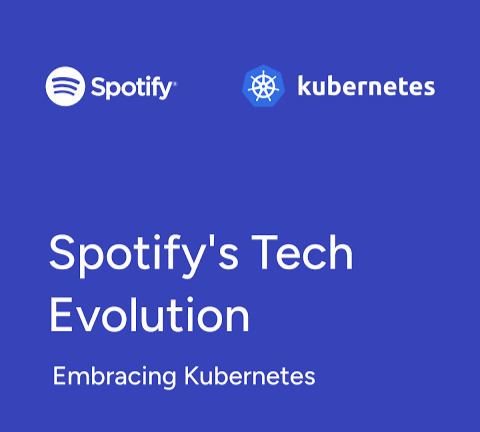Spotify’s Migration to Kubernetes Company: Spotify
 Ashish Bhangale
Ashish Bhangale
Company: Spotify
Industry: Entertainment (Audio Streaming)
Global User Base: Over 200 million monthly active users
Challenge
Spotify, launched in 2008, grew rapidly and needed to ensure a smooth user experience for its creators and consumers.
They used Helios, their own container orchestration system, to manage microservices across Virtual Machines (VMs).
By 2017, it became inefficient for a small internal team to maintain Helios.
Spotify decided to switch to Kubernetes, a tool with a larger community, better support, and more features.
Solution
Spotify recognized Kubernetes had a strong community, better features, and would reduce costs while increasing development speed.
They started migrating from Helios to Kubernetes without completely shutting down Helios to minimize risks.
With Kubernetes, Spotify's teams could create new services much faster—what used to take hours now takes seconds or minutes.
Kubernetes also improved CPU utilization by 2 to 3 times through bin-packing and multi-tenancy capabilities.
Impact
The migration to Kubernetes began in late 2018 and accelerated in 2019.
A small percentage of Spotify’s services were migrated initially, but the benefits were clear:
Less time spent on manual capacity provisioning, allowing teams to focus more on developing features.
Autoscaling helped handle over 10 million requests per second for some services.
Increased speed in service deployment improved Spotify’s agility.
Spotify also created internal tools like Slingshot (temporary staging environments that self-destruct after 24 hours) using Kubernetes.
The migration helped Spotify align with industry standards and collaborate more with the Kubernetes community.
Key Takeaways
Why Migrate? Spotify switched to Kubernetes because maintaining their homegrown solution (Helios) was inefficient, and Kubernetes had better support and features.
Community Power: Kubernetes’s large community and tools like autoscaling and multi-tenancy allowed Spotify to be more efficient and agile.
Real-Time Impact: Teams no longer wait hours to deploy services—Kubernetes made it possible in minutes.
Real-Life Example:
Imagine running a large grocery store. You previously built a system that organizes product inventory, but it’s hard to manage with your small team. You decide to adopt a new, widely-used system that can automatically adjust inventory, helping your store run more smoothly. Now, instead of taking hours to update stock and pricing, it happens in minutes, letting you focus on serving customers better.
Notes (Easy to Remember)
Helios → Kubernetes: Spotify moved from their system Helios to Kubernetes for better support and efficiency.
Autoscaling: Kubernetes automatically adjusts to handle more requests, reducing manual work.
Speed: Service creation now takes minutes instead of hours.
Tools: Spotify built tools like Slingshot on Kubernetes, creating new possibilities for internal use.
Community Benefits: Spotify contributes to and benefits from the Kubernetes community.
This case highlights how a company as large as Spotify adopted an open-source, community-driven solution (Kubernetes) to streamline oper
ations and scale efficiently.
Subscribe to my newsletter
Read articles from Ashish Bhangale directly inside your inbox. Subscribe to the newsletter, and don't miss out.
Written by

Ashish Bhangale
Ashish Bhangale
I am a dedicated web developer with a strong focus on Java and a keen interest in AWS and cloud computing. Currently pursuing my MCA, I am driven by a passion for exploring emerging technologies and solving complex problems. As an aspiring software engineer, I am committed to leveraging my skills to create impactful solutions. In addition to my technical pursuits, I enjoy writing blogs on technology, sharing insights, and contributing to the tech community. My goal is to blend my technical expertise with a love for communication to foster a deeper understanding of technology.